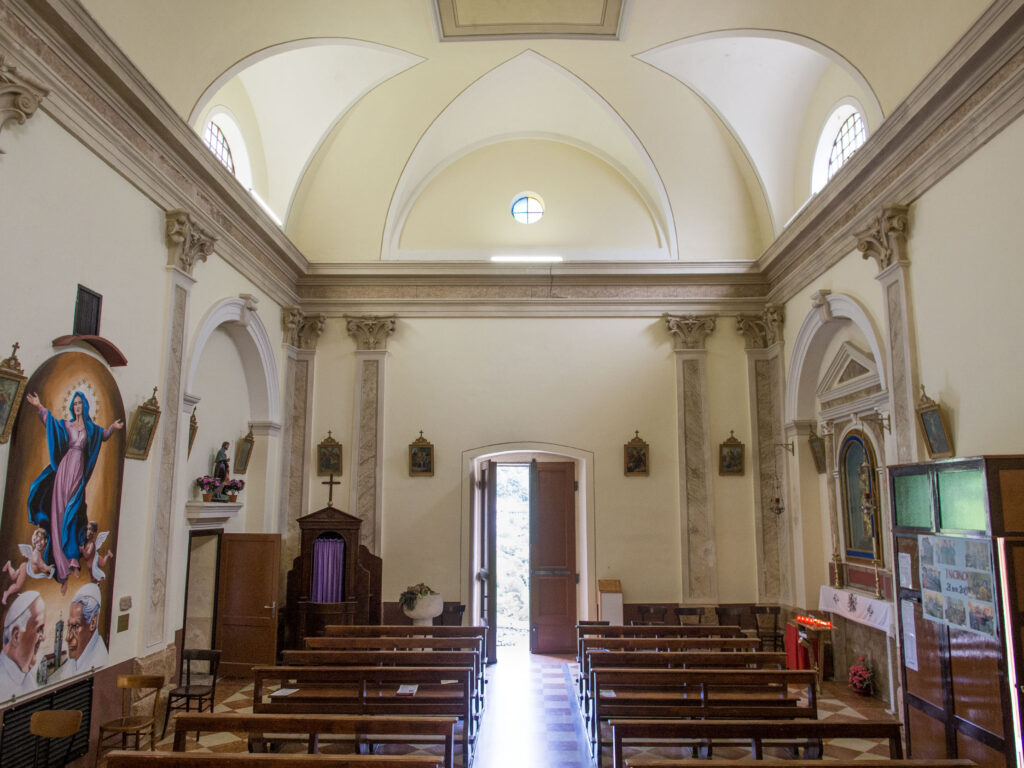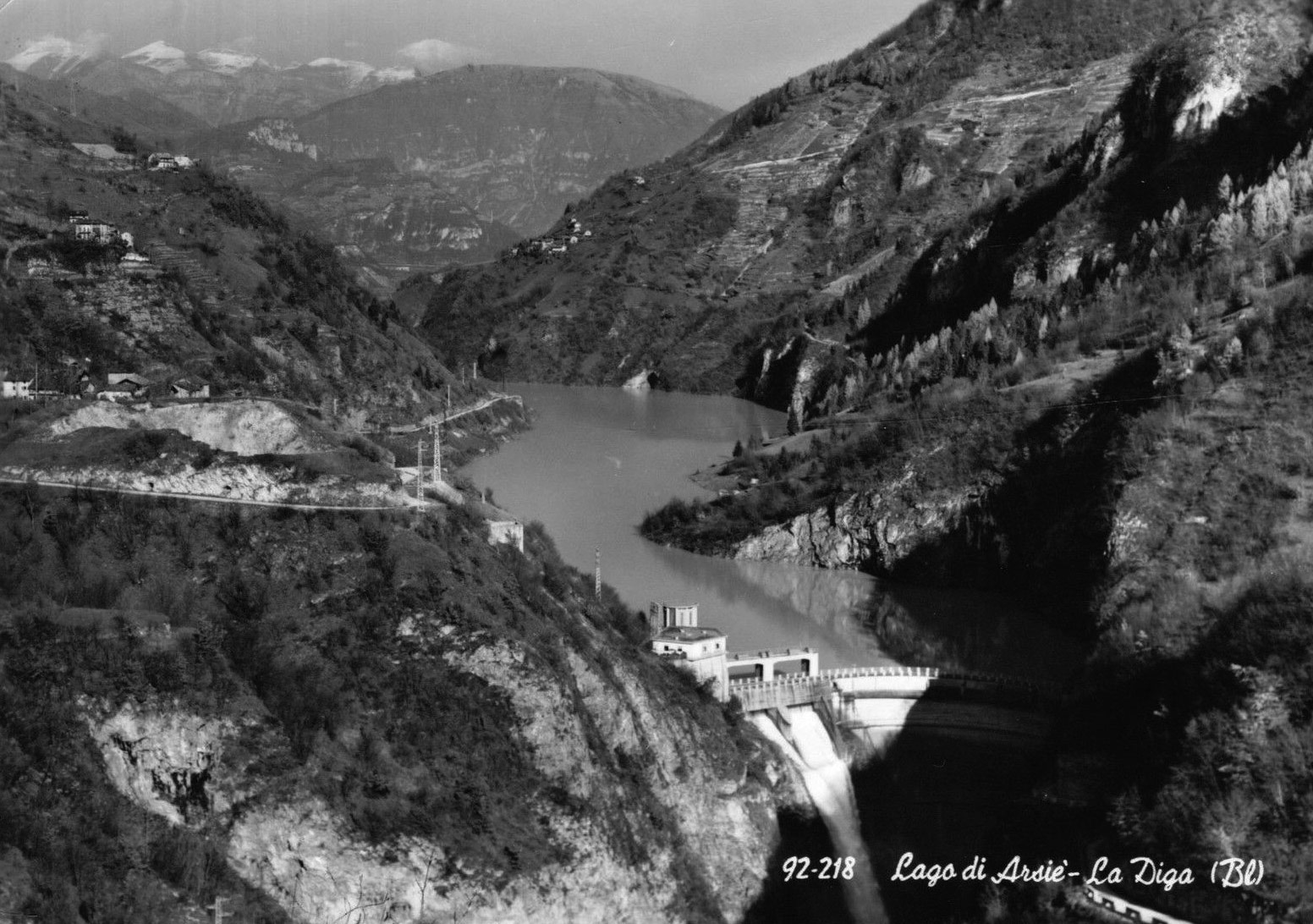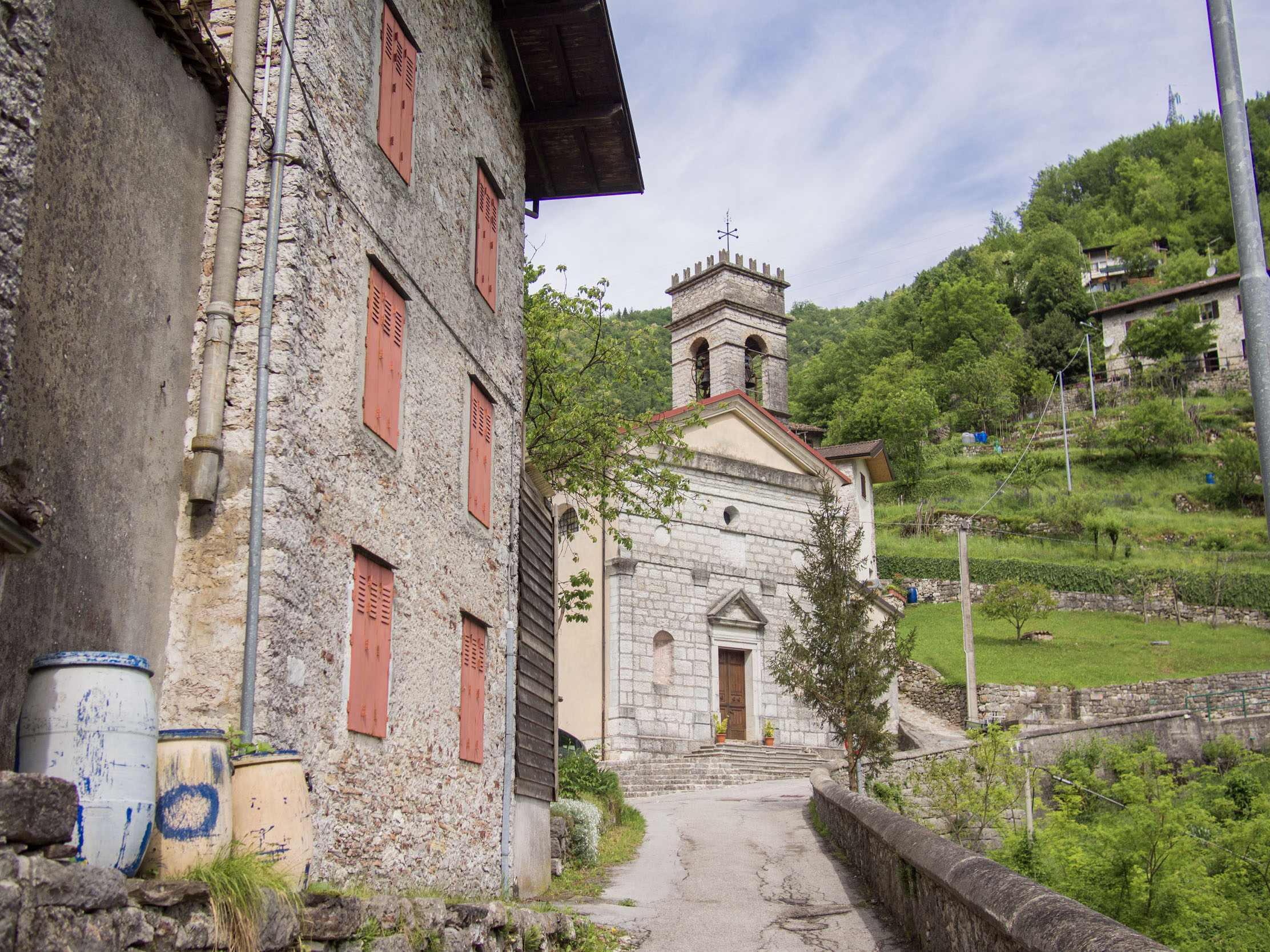The History of Incino
1961 — 2016: Decline
1961
On August 19, Don Eugenio Alberelli arrives as curate. His achievements are considerable: rearranging the altars and the choir, painting the entire church, having heating installed, marble flooring (thanks to a £1,200,000 grant from the prefecture), and the sheet-metal roof. The parsonage was also renovated. To cover the expenses of more than £5,000,000, all Incino’s residents competed to finance the work. And let us not forget the help from Pope John XXIII, who donated £100,000 to the church.

Unfortunately in this period a great portion of the church’s sacred objects were sold: choir seats, basins, crucifixes, and more, with chagrin that persists to this day.
In the month of March, the statue of Saint Anthony is installed in the shrine in Tanisoi and blessed.
In autumn, Servizi Autobus Dolomiti (SAD) extends the route of the Arsiè–Rocca bus up to Incino with three daily trips: at 7:00 A.M., 2:00 P.M., and 6:00 P.M.. The stop is placed on Drio el Col and not in the Church piazza because Valentina Zancanaro’s house in Caneve prevented even cars from passing (the house will be demolished only in 1968).
The first bus route to Incino had been established in 1954. The Cometto Company of Feltre started service that lasted only a few weeks because the town government couldn’t agree on how much of the costs to cover, but in 1961 bus service was brought back to Incino since the town needed to transport its pupils to the new compulsory unified middle school.
1963
This year Incino’s aqueduct was rebuilt. The work was performed by the Lorenzini-Brandalise Company. Water was collected from a spring near Incino at a height of 400 meters (above Col) where a basin was built, from which a water main ran to Incino and Corlo. It cost £5,000,000.
This year the population comes to 181 residents, with 59 families—in the last five years 18 families have left.
1965
In 1965 the road from Rocca to Incino was paved, while in 1970 the stretch between Incino and the border of Cismon was paved. There were five televisions in the village that year—two in the parsonage, three in private houses. Between 1964 and 1965, a cinema will operate in the parsonage to the delight of the young people, but after a year it was suspended because the proceeds didn’t cover the expenses.
Also in 1965, Bishop Bordignon comes to Incino for his second pastoral visit, where he administers confirmation to a group of young people. At Sunday Mass almost the entirety of the population attended, no more than three or four people were missing, always the same ones. Attendance at Vespers was high as well—never less than 80 worshippers present. On summer evenings at least 30 people would go to the cemetery each day to recite the Rosary.
From 1956 to 1964 there were 7 marriages and 20 deaths. There were 18 families who left the village. 27 workers are working abroad, 15 in Italy. The year ends with the final loss of a child in Incino: on December 29, Rosanna Zancanaro, daughter of Lorenzo from Tanisoi, dies from leukemia. She was 9 years old.
1967
At the end of June, Don Eugenio leaves Incino, which is reduced to 136 inhabitants, and the curacy returns to its origins—which is to say, under the authority of the parish priest of Rocca, then Don Lino Minuzzo.
1970
In June, at the end of the school year, Incino’s school is closed for lack of students. The last to attend the elementary school were Stefania Zancanaro and Moreno Zancanaro.
In the summer the hamlet of Tanisoi is connected to the main road with an access road that allows direct entry.

In December, with the death of Antonio Grandi (“Toni from the Cooperative”), one of the two grocery stores closes. His had been open without interruption since right after the war.
1973
The population of Incino drops below 100. At the end of the year there will be 97 inhabitants.
1974
October 8
The third pastoral visit of Bishop Bordignon. 92 residents, 37 families, 60% go to mass, the vice of blasphemy is still pervasive along with theft, malice, and mutual spite, according to Don Giuseppe Cherubin.
1975
Angela Zancanaro dies, sister of Angelo (“Puiol”). She had been the first nun native to Incino, with the name of Sister Paola. After her Maria Zancanaro, the daughter of Angelo Zancanaro (“Puiol”) and Giovanna Strappazon (“Baiana”), assumed the veil and took the name Sister Antusa. She died at 77 on August 29, 1989 and her remains lie in Arsiè. The third nun from Incino (Pomer) is Valentina Grando, born in 1932 to Gelindo and Maria Martinato, and still living, with the name of Sister Adiodata. She served for decades as a hospital attendant in Vittorio Veneto and is currently retired in a motherhouse. All three sisters were part of the Institute of the Sisters of Mercy in Verona.
1976
On June 6 in Padua, Don Sandro Borsa is ordained a priest. He is our third villager to enter into the clergy. Almost his entire priesthood will be spent as a missionary in Kenya.
1979
On February 11, a meter of snow falls in a single day. In March, Anna Demontis, wife of Giacomo Zancanaro, closes the last grocery store, which had been acquired by Giacomo’s mother “Milgia.”
1983
December 31
The last tavern, run by Antonietta Zancanaro, closes in the piazza.
1985
A new snowfall record on January 15: one meter and 30 centimeters of snow. The entire Feltrino is brought to its knees and Incino remains snowed in for two days. On December 8th of this year, all the men in the village place the first Christmas tree in the piazza, a tradition that has continued to this day.
1987
With an official decree, the Bishop of Padua Monsignor Filippo Franceschi orders the dissolution of the curacy of Incino, to take effect January 1. The independence of the church of Incino from the parish of Rocca lasted 57 years.
Residents in Incino: 57 people. There are 29 families, 2 children under 14, 11 young people under 27, 28 adults up to 65, and 16 elders over 65, 12 of whom are women.

1990
A series of vitally necessary public works are carried out in Incino: the Rocca–Incino road is widened with the construction of multiple retaining walls, the aqueduct is connected to the one Rocca, and the village is equipped with adequate public lighting. Of all these works, the most appreciated was the permanent solution for the aqueduct. The prior one from Col was unable to collect enough at its source, causing home-supply crises during the population spikes each summer (and often in winter too). There would be grave distress among the residents who were forced to get water from the fountain in the piazza, waiting for the army to replenish the fountain basin with its water trucks.
All this work was drawn up and paid for by the Dall’Agnol administration, in office since 1985. The village’s decades of abandonment and neglect at the hands of previous Christian Democratic administrations were finally over. In June, the lake is completely emptied for its second time to make safety repairs.
The widening of the aforementioned road allowed Dolomitibus to restore its Rocca–Incino route, which had been suspended 5 years prior for safety reasons.
1993

In April, the agriturismo Al Ciod is opened in Prai by Carlo Miglioretto from Solagna. There had never before been a restaurant in the vicinity of Incino. It ought to be remembered that its opening resulted in high tensions with all the other inhabitants of the hamlet.
1997
March 3
Exceptional fishing for Luigi Brandalise: in the waters of the Cismon he caught a trout 85 centimeters long, weighing six and a half kilograms.
1999
On May 29, in the church of Incino, Maria Rosa Zancanaro and Simone Cavalli from Valstagna were married. Maria Rosa is the last bride to go up to the altar of our church. There will be no others since there are no more young people.
2000
The Ferarro family from Cismon stops supplying Incino with fruits and vegetables. In 1950, Angelo Ferraro (“Feia Bianca”), supplied the food for the cafeteria of the dam workers posted at Cusine. On the way back he would stop in Incino where he sold mostly produce until he passed away in 1953. Immediately his sons Evelio (“Elio”) and Antonio (“Toni”) took over, restocking the village twice a week without interruption. Evelio died in 1996, and his brother continued until the spring of 2000 when he retired, closing the store in Cismon and ending delivery to the various hamlets of Arsiè. In the end, the Ferraro family brought fruits and vegetables to Incino for exactly 50 years.
Other suppliers who are remembered are Nani Nelo, Bepi Mosana, and more recently Toni (Napoletan).
2003
On May 10, a Ford Sierra driving up from Cismon to Incino tore out several poles, sliced through two steel guard cables, and careened into the Cismon River from a height of 40 meters. Two young men from Rocca lost their lives: Matteo Riosa, 24 years old, and Andrea Brandalise, 25 years old, who was residing in Incino at the time. No one could remember any accidents at that site before, even when the road had been unprotected.
The Incino–Cismon Road is closed to traffic for 17 months. It will be reopened at the end of October, 2004, after Arsiè installs the strongest safety measures possible.
The summer of this year is the most sweltering in human memory.
2004
On June 20, 81-year-old Incino native Elia Fantin and his 78-year-old wife Pierina Canessa from Rapallo lose their lives in an auto accident near Pederobba. Married in 1966 after several years of living in Switzerland, they returned to Italy to become indefatigable evangelists for the Jehovah’s Witnesses, leading players and trailblazers in Belluno and then in Feltre. Elia had long been an Overseer (a bishop) and was very well known throughout the Feltrino for his tireless promotion of his faith.
July 14
Maddalena Zancanaro leaves the village for the retirement home in Arsiè. The news is banal, but thus Incino drops below 20 inhabitants. Now we are 19, unfortunately destined to fall still more. Note that just a hundred years ago, Incino had 517 inhabitants. In exactly a century, the village has lost 97% of its population.

2005
On February 24, Gelindo Moretti leaves the village for the retirement home in Arsiè. Now there are 18 inhabitants.
At the end of October, work is finished on the rural silvo-pastorale road that runs from Porteghetti in Cismon del Grappa and winds up Monte Grappa opposite Incino.
2006
Between January 26, 27, and 28, a supersnowstorm falls on Incino. The 130 to 140 centimeters of snow are a heavy burden, especially in clearing the inner streets of the village.
In April the Faoro administration installs hundreds of meters of guardrails along the road to Rocca.
August
The second edition of The History of Incino is printed. The first saw the light of day in August, 2004, and now we have sought to include all the news since. It is the story of our village. May reading it make you shudder to think about what Incino once was, and what now is almost no more.
September
Most of the church interior is repainted. The work was done by the Guidolin Company of Fastro. On September 30 in the church of Incino, with Don Sandro officiating, Paolo Borsa (son of Dario) and Marta De Mattia (from Conegliano Veneto) are united in matrimony.
2007
One of the mildest winters of the last thirty years: almost nonexistent snow, falling just twice, on January 25 and March 21 with three centimeters each time at most. In February the first home health aide arrives in Incino, which is normal elsewhere but here it is an utter novelty.
2011
On February 8, Teresa Zancanaro dies at the retirement home in Arsiè. She was 101 years and 8 months old, the oldest person from Incino ever.
2013
On October 19, on the eve of the Souls Fair [link in Italian], the Zancanaros held their first reunion. At noon, by the warehouse in Arsiè, about a hundred people could be found from throughout the Triveneto, meeting the many descendants whose ancestors had left Incino many decades back. After lunch, the reunion continued on to Incino with a mass and a tour of the village.
November 21 marks the celebration of the Madonna della Salute and the 110th anniversary of the construction of the church. The Bishop of Padua Antonio Mattiazzo comes to Incino to celebrate mass at 3:00 P.M.. To honor the event, a week earlier most of the church interior was repainted and the outside steps were repaired. Despite inclement weather, there was a mob scene of worshippers from all the neighboring villages—more than 200 people packed into the church, followed, afterwards, like every year, with an elaborate buffet.
2016
July 3
On the 70th anniversary of the construction of the shrine in Somanzin, local volunteers restored its artifacts and the results are blessed. Don Alberto Peron presides with about 70 people attending.
September 4
In Casere, restoration starts on the shrine to the Madonna. Mass is celebrated by Arten’s pastor Don Arnaldo Visentin with a congregation of 45 people. The restoration is performed by the brothers Pierantonio and Renato Zancanaro.
November 21
The celebration of the Madonna della Salute is held, the church is packed with at least 125 worshippers, with Don Alberto celebrating, afterward the usual sumptuous refreshment—